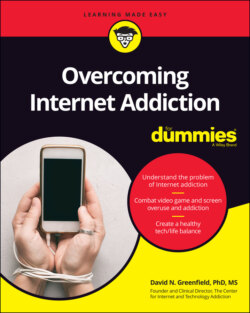Читать книгу Overcoming Internet Addiction For Dummies - David N. Greenfield - Страница 40
THE ROLE OF UP-REGULATION AND DOWN-REGULATION IN ADDICTION
ОглавлениеAs a person increases dopamine in the limbic reward system of their brain, this translates into increased pleasure; not surprisingly, pleasurable behaviors tend to be repeated, especially when there is an unpredictable or variable element to the pleasurable hit. Biologically, this is where up-regulation and down-regulation come in.
As the nucleus accumbens is hit with signals that increase dopamine, the post-synaptic receptor binding sites (call them Pacmen, as in the video game) first begin to up-regulate (become more plentiful) and are constantly occupied by dopamine. The receptor sites then slowly respond less to the same levels of dopamine. This is called down-regulation (or desensitization), and it makes sense that this would produce tolerance, meaning that you would need more stimulation to get the same effect, which I discuss earlier in this chapter. This is because to keep those neurons firing, they now need more stimulation, and this increase produces down-regulation or desensitization. With technology and screen addiction, this might mean more intense or stimulating content, faster Internet speeds, quicker access, more frequent use, or longer use times — all of which we tend to see with Internet and technology addiction.
All this can lead to the development of reward deficiency syndrome, which occurs when the reward center acclimates to that intense level of stimulation and only receives a significant dopamine hit when engaging in excessive or intensive screen time; by comparison, everything else looks and feels flat and uninteresting. This is a very common complaint from parents and family members where their addict loved one no longer takes pleasure in any previously pleasurable behaviors. This is essentially an example of down-regulation, in that when those hungry Pacmen are consistently fed, they need more stimulation to get the same effect. Real-time living no longer provides the stimulation necessary to fire those neurons in the nucleus accumbens in order to help a person feel good or to experience pleasure from normal living. Those receptors become used to being occupied, and they become accustomed to the resulting increased dopamine levels. Unless the person is continuously excited by repeated Internet or screen use, they experience a biological deficiency in the form of psychological symptoms such as boredom and feeling “blah,” anxious, irritable, unmotivated, or even depressed.
This is a tough place to be because there is a high likelihood of relapse at this time; we generally want to feel good, and the quickest way to feel good is to engage in the behavior that we know will get that result quickly. It’s also a difficult time because the motivation to engage in other real-time behaviors that could eventually prove to be fun and stimulating (dopaminergic) is very low, and it also takes some time for the receptors to re-regulate. This creates a challenging period for the addict and their family, as it occurs between the discontinuation of the old behavior and its resulting neurochemical effects, and engagement in the new behavior, with its more balanced neurochemical state. This new desired state of up-regulation is sort of the opposite of down-regulation on a biological level, and involves getting the dopamine receptors in the nucleus accumbens to re-sensitize to more normal levels of real-life stimulation. The Internet is very stimulating, and things like video games, YouTube, pornography, or even social media can retrain our nervous system to get used to that stimulation.
